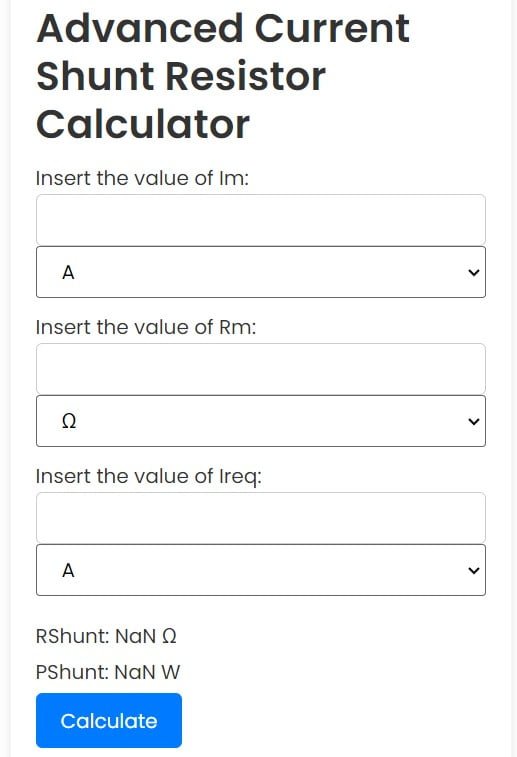Introduction:
The shunt is a component in the circuits that perform measuring processes and therefore contributes a lot to the accuracy of the current measurement. Regardless of whether you are an electronic enthusiast, hobbyist, or professional engineer, if you are to work on anything related to electronics, you will need to have a good grasp on the basic properties of shunt resistance, its calculation, and the role it plays, among others. Throughout this article, shunt resistance, its importance, and how to use a reliable shunt resistance calculator are the subject of discussion.
How to use a current shunt resistor calculator
To use the shunt resistance calculator please follow these steps:
- Step-1:First enter the full-scale deflection current (Iₘ) of the meter in the ampere unit.
- Step-2:Here provide the value of Rₘ in ohm unit. Rₘ indicates the internal resistance of the meter.
- Step-3: In the third outline enter the required current (Iᵣₑq) value in the ampere unit and it must be higher than the full-scale deflection current (Iₘ) of the meter.
- Step-4:At last click the calculate button to get the ultimate value of shunt resistance.
Table of Contents
What is Shunt Resistance?
A shunt resistance, which also is called a current shunt resistor, is a low-resistance resistor that is used in a parallel connection to a component or a circuit in order for the current to be diverted. Mostly, however, it is employed in ammeters and various other instruments to find out the current accurately unless there is a voltage lost significantly.
Importance of Shunt Resistance:
Shunt resistance plays the important role of using a small quantity of total current to measure accurately via partitioning with devices like ammeters. If a shunt conductor was not used, the ammeter would mainly result in increased voltage drops across itself and thus reduced measurement accuracy and possible damage to the instrument.
How It Works:
The shunt resistance always has a very low resistance value. Thus, the current seeks a path through the shunt resistance instead of the ammeter or the other measuring devices. When current goes through the circuit, the shunt resistor is where a portion of it appropriately flows, while the total of the rest sues the original path. The voltage drop across the shunt resistor determined through Volt/Ohm law is equivalent to the amount of current passing through the circuit.
Formula:
The formula to calculate the value of the shunt resistance:

Where:
- Rₛₕᵤₙₜ is the shunt resistance,
- Rₘ is the internal resistance of the shunt,
- Iₘ is the full-scale deflection current of the meter,
- Iᵣₑq is the value of the required current
Why Use a Shunt Resistance Calculator:
The shunt resistance computation is both complex and time-consuming, so at least for a selected application it is difficult. To be true, no tool can simplify all processes, but a shunt resistance calculator facilitates this process and makes it easier and faster. The calculator inputs all the parameters, including the maximum current let, the desired voltage drop, and the shunt resistor tolerance value. Thus, it returns the optimal shunt resistance value for the circuit.
Conclusion:
Shunt resistance is a critical component in various electronic circuits, particularly in instrumentation and measurement applications. Understanding its significance, and formula, and how to calculate it accurately is essential for designing precise and reliable systems. With the aid of a reliable shunt resistance calculator, engineers, and hobbyists can streamline the design process and ensure accurate current measurements in their circuits.
Incorporate a shunt resistance calculator into your toolkit today, and unlock the potential for precise current measurements in your electronic projects. Explore our website to access our intuitive shunt resistance calculator and enhance your electronics endeavors.


